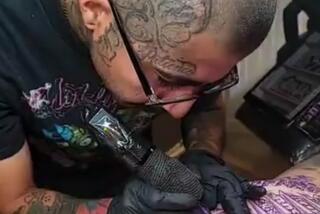Illustrated Man Is No Skinflint
- Share via
He got the tattoos, he says, because he “wanted to be an outcast.”
“It seemed like every time I would get close to somebody, I would do something to drive them away. Everyone I was ever close to I lost, and I did not want to get hurt any more.”
So, Gary Steuer says, he spent $50,000 and every Tuesday night for four years in a tattoo parlor in West Hollywood.
Oddly, he says, the intricate kaleidoscopic pattern--which features five animals pursuing an elusive pearl of wisdom--achieved the opposite of the desired effect: It bought people closer to him.
“The tattoo changed me,” says Steuer, 47, a plumber at UCLA. “People were attracted to it at first. Then after the idea of the tattoo went away, they were attracted to me. . . . I opened myself up and started to let people in. . . . Before, I tried to keep secluded.”
His tattoos, finished in 1989, cover everything but his head, hands, feet and groin.
“It hurt, but probably not in places you’d expect,” he says. “The rib cage, the area of skin just under the rear end, and I think the worst spot was the knee cap. It felt like it was going right into the bone. I’m glad it’s done.”
Steuer sometimes wears a long-sleeved shirt and pants so he won’t shock people: “I don’t want to offend anybody. Even though (tattooing) is gaining acceptance, it’s still a subculture.”
He doesn’t see himself as different except in one way. “There is a difference in my appearance,” he says. “But I’m so used to it that I don’t see the tattoos, and the people around me any length of time don’t notice them either. And they will comment on how people stare.”
First-timers, however, can sometimes act rashly. “I was going through Palisades Park one Sunday afternoon,” he says, “and some women there with their husbands reached over and tried to undo my pants (to see the tattoos there. It was) rather embarrassing.”
Strangers also start unusual conversations. “They ask me questions they would not think to ask anyone else because they think I’m on the fringe of society,” he says. “They even ask questions regarding sex. Is sex different because of tattoos? It seems strange, but this is how other people think.”
Most reaction is positive, especially with students at UCLA, where Steuer has worked for 15 years. “I do not think a day goes by that I am not involved in some conversation about the tattoo,” he says. “They usually ask basic questions. Did it hurt? How much did it cost? Are they all over (you)?”
Artist Greg James, who applied Steuer’s tattoos, said designs as extensive as his are not unusual.
“I have several clients I’m doing body suits on,” James said, “but they are not quite as energetic as Gary. In other words, it will probably take a lot longer to get the same coverage.”
Steuer, who lives in Santa Monica, grew up in Forest Hills, N.Y. He says he became a loner after he went to Vietnam with the Marines in 1963. He says most of his boot camp unit was wiped out in the war; two weeks after his tour, six other friends perished.
By the time he returned home in 1967, he says, his father had died and he could not find his older brother, who had been sent to Europe in the Army. His mother had remarried, and she and his sister had moved. It took years to find his family.
Steuer, who has studied martial arts since he was 11, came to California in 1968 to work with a kung fu grand master. Although he had four tattoos done while he was in the service, he says the death of this grand master in 1985 pushed him to begin his full-body design. He says the tattoo commemorates the kung fu style called “the five animals.”
“Once I started, I had to complete it,” he says of his body designs, which won him honors at a national tattoo convention. “I had started to get compliments on it, and I knew it was the right thing. . . .”


